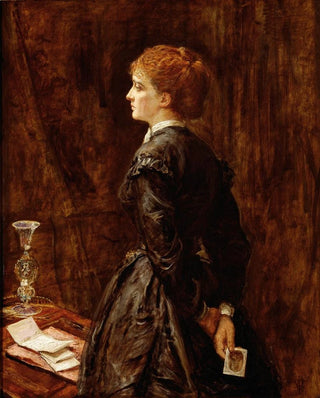Art print | Yes or no - Sir John Everett Millais


View from behind

Frame (optional)
Reproduction Yes or No - Sir John Everett Millais – Engaging Introduction
The artwork "Yes or No" by Sir John Everett Millais is set during a pivotal period in art history, where the Pre-Raphaelite movement establishes itself as an innovative force, blending romanticism and realism. This painting, which captures the very essence of human emotions, invites viewers to reflect on life's choices and dilemmas. Through the intense gaze of the characters and the richness of detail, Millais manages to create an atmosphere that is both intimate and universal. The question posed by the title resonates with a depth that transcends eras, encouraging everyone to consider their own decisions. This painting, a true mirror of the soul, deserves exploration both for its technique and its message.
Style and uniqueness of the work
Millais's style in "Yes or No" is distinguished by an impressive mastery of color and light, which give each element an almost tangible dimension. The faces of the protagonists, imbued with infinite delicacy, are rendered with a precision that borders on photography. The meticulous details of clothing, accessories, and backgrounds reflect careful observation of the world surrounding the artist. Millais employs a rich and varied palette, oscillating between vivid hues and darker shades, creating a striking contrast that emphasizes the characters' emotions. This work stands out for its ability to capture a fleeting moment, where time seems suspended, allowing viewers to immerse themselves in the intensity of the visual narrative.
The artist and his influence
Sir John Everett Millais, co-founder of the Pre-Raphaelite movement, left a lasting mark on art history with his bold vision and commitment to a faithful representation of nature and human emotions. His work goes beyond mere aesthetic concerns; it is nourished by literary and philosophical influences of his time, resonating with the ideals of Victorian society. Millais skillfully combined a romantic style with rigorous technique, inspiring many artists across generations. His ability to tell stories through his paintings paved the way for a new form of artistic expression, where visual storytelling becomes just as important.

Matte finish

View from behind

Frame (optional)
Reproduction Yes or No - Sir John Everett Millais – Engaging Introduction
The artwork "Yes or No" by Sir John Everett Millais is set during a pivotal period in art history, where the Pre-Raphaelite movement establishes itself as an innovative force, blending romanticism and realism. This painting, which captures the very essence of human emotions, invites viewers to reflect on life's choices and dilemmas. Through the intense gaze of the characters and the richness of detail, Millais manages to create an atmosphere that is both intimate and universal. The question posed by the title resonates with a depth that transcends eras, encouraging everyone to consider their own decisions. This painting, a true mirror of the soul, deserves exploration both for its technique and its message.
Style and uniqueness of the work
Millais's style in "Yes or No" is distinguished by an impressive mastery of color and light, which give each element an almost tangible dimension. The faces of the protagonists, imbued with infinite delicacy, are rendered with a precision that borders on photography. The meticulous details of clothing, accessories, and backgrounds reflect careful observation of the world surrounding the artist. Millais employs a rich and varied palette, oscillating between vivid hues and darker shades, creating a striking contrast that emphasizes the characters' emotions. This work stands out for its ability to capture a fleeting moment, where time seems suspended, allowing viewers to immerse themselves in the intensity of the visual narrative.
The artist and his influence
Sir John Everett Millais, co-founder of the Pre-Raphaelite movement, left a lasting mark on art history with his bold vision and commitment to a faithful representation of nature and human emotions. His work goes beyond mere aesthetic concerns; it is nourished by literary and philosophical influences of his time, resonating with the ideals of Victorian society. Millais skillfully combined a romantic style with rigorous technique, inspiring many artists across generations. His ability to tell stories through his paintings paved the way for a new form of artistic expression, where visual storytelling becomes just as important.






